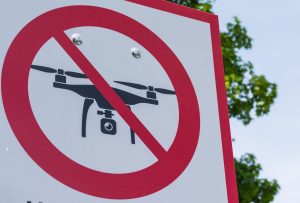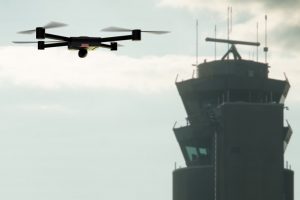We sat down with Jason Cansler, owner of UASidekick, LLC, which provides software for UAV pilots to maintain compliance with FAA requirements, to discuss the challenges and opportunities security organizations face when using drone technology.
Q: The use of drones and other unmanned systems in the security industry has been a hot topic over the past few years.  How are drones affecting an organization’s approach to security?
How are drones affecting an organization’s approach to security?
A: There’s so much drones can do to augment security. They are being used to look at perimeters and conduct constant surveillance over large areas. Drones can also be sent out as a response mechanism before personnel can respond and conduct an initial site assessment, so people know what they’re getting into before they get there. It’ll take a little bit for people to get used to what they can do with drones, and when regulations loosen up, it will open up a whole other world in the security industry.
Drones are getting smaller, and their battery and fuel sources are getting more efficient. You’re finding more drones with better camera systems and a smaller footprint. The key aspects that make people buy certain drones are flight time and payload capacity, but the best drone you have is the one you have with you.
Organizations also need to consider how to protect their assets from drones. This is another aspect to security that’s taking longer for people to understand the impact. And, policies need to be made so employees know what to do when they see a drone. Do they notify someone? Is there a ground sweep? Do they see if anything was dropped from the drone? Do you check rooftops for listening devices? Every company should have a drone policy, just like any other health or safety policy, whether you’re a school that would need to protect children, or a company with assets on their property, and especially jails and prison systems. Whether or not an organization has a drone program, they need drone policies.
Q: There are a lot of people in the security industry who are curious about the possibilities drones can provide as a physical security tool. Are you seeing an increase in the use of drones for security purposes?
A: Recently, there are more options that can support and provide drones as a security function. Companies need turnkey devices—they don’t want to go through the process of learning this on their own. If you can have a consultant or integrator that already has this experience under their belt, you’ll start seeing this implemented more, especially once integrators understand the systems and what it takes to actually incorporate them.
But overall, the growth is still slow—the industry is trying to determine where the technology is going and what they can do with it. There’s not a lot of litigation that supports how drones are used, even in law enforcement circles, which often looks at case law to know how it might be used for or against you in a case. And the lack of legal permission to fly drones beyond line of sight is causing some disruption for companies that want to patrol a thousand acres—they would have to someone in view of that drone at all times, which defeats the purpose.
Q: When do you think we will see more clarity on how drones can be used in security or law enforcement capacities? Is that the biggest barrier to the adoption of this technology?
A: We thought this year we’d be able to operate drones beyond the line of sight and over people, but the law is still not there. Regulations are being held up by the lack of remote identification—the requirement for a drone to signal that its flight has been authorized. Right now, law enforcement can’t tell whether the drone operators are good or bad guys.
 The whole key is to find bad actors, not keep track of good ones. In a perfect world, if you see a drone but don’t have any ID pings, you’d know that is a bad actor. It will be very important in the future to have remote ID capabilities for traffic management and security. They want that capability in place before they allow people to fly drones beyond visual line of sight.
The whole key is to find bad actors, not keep track of good ones. In a perfect world, if you see a drone but don’t have any ID pings, you’d know that is a bad actor. It will be very important in the future to have remote ID capabilities for traffic management and security. They want that capability in place before they allow people to fly drones beyond visual line of sight.
Q: During this time of uncertainty surrounding regulations, how are organizations using drones? What challenges do they face?
A: There are some organizations who have taken up the mantle and are using drones because they’re more concerned about the safety of their product, property, or people, and will take whatever hand-slapping they get as long as they’re able to protect their assets. You’ll find that taking place more overseas in Mexico, Venezuela, and Africa—people are using it because they need it, they have assets they have to protect. Most of the time it’s in coordination with local governments, but here in United States, we’re kind of stuck until we get this approval through the FAA or Congress.
Some organizations are taking a more careful approach and won’t really use drones until they find out how other companies fare, but the question of enforcement is unknown. Some fines have been given, but they aren’t broadcast, which kind of defeats the purpose. The FAA licenses pilots to be able to fly, but they aren’t an enforcement agency. They can revoke licenses, but actual enforcement is left up to the Department of Justice or FBI. For them to go after drone pilots, there has to be some other precipitating issue, like they crashed and hit something or used them nefariously. We’ll start to see more and more of this—the FAA is providing resources to get local law enforcement to help.
Q: What can security professionals do to stay up-to-date on advances in drone technology, regulations, and use  cases?
cases?
A: In our presentation, Drone Evolution: Security Tools or Security Threats?, that we’ll be leading while at Global Security Exchange (GSX) this September in Chicago, we will discuss information from regulatory requirements and case studies on how drones can interfere with security measures for a small or large company, or even a government agency. The three of us giving the presentation—myself, Nathan Ruff, and Mark Schreiber, offer a good combination of perspectives with my pilot’s point of view, Mark’s engineering background, and Nathan, who’s an expert in the unmanned systems industry. We participate in different rulemaking committees, NASA groups, and a safety team for FAA. Some of the information that comes through these channels we’re privy to, and we can and will talk about what we’ve learned.
—————————
To hear Cansler and other experts speak on these topics, see live drone demonstrations in the GSX D3 (Drones, Droids, and Defense) learning theater, and to meet with reputable companies who supply drone technology, register for GSX at www.gsx.org


 With corporations placing an increased importance on duty of care, it is a priority for security professionals to have a solid medical risk management plan for meetings before an incident occurs. There is nothing associated with more liability at an event than a medical emergency improperly managed.
With corporations placing an increased importance on duty of care, it is a priority for security professionals to have a solid medical risk management plan for meetings before an incident occurs. There is nothing associated with more liability at an event than a medical emergency improperly managed. We’ve seen the rapid development and expansion of the cloud and Internet of Things (IoT) impact almost every aspect of the security industry; from surveillance technology to video management systems to data storage, the opportunities presented by increasing interconnectivity and communication between devices have revolutionized the way users handle security operations. And the access control market is no exception: according to research by Security Sales & Integration, 71 percent of companies were deploying a networked access control system in 2017.
We’ve seen the rapid development and expansion of the cloud and Internet of Things (IoT) impact almost every aspect of the security industry; from surveillance technology to video management systems to data storage, the opportunities presented by increasing interconnectivity and communication between devices have revolutionized the way users handle security operations. And the access control market is no exception: according to research by Security Sales & Integration, 71 percent of companies were deploying a networked access control system in 2017. As a business attorney, one of my most important obligations is to help clients manage their legal risks, which these days include exposure in the cybersecurity/data breach arena. One expanding area of concern is liability for a third-party vendor’s data breach. If your business shares confidential information with third-party vendors in its line of work, you are now obligated to ensure that those vendors keep that information secure. If the vendor fails to do so, your business could be liable for the damages that flow from a data breach involving your information. Luckily, there are a several ways to help protect your business on this front.
As a business attorney, one of my most important obligations is to help clients manage their legal risks, which these days include exposure in the cybersecurity/data breach arena. One expanding area of concern is liability for a third-party vendor’s data breach. If your business shares confidential information with third-party vendors in its line of work, you are now obligated to ensure that those vendors keep that information secure. If the vendor fails to do so, your business could be liable for the damages that flow from a data breach involving your information. Luckily, there are a several ways to help protect your business on this front.
 We’re officially within 10 days of Global Security Exchange (GSX) 2018! As the industry’s flagship event for more than 60 years, the newly rebranded GSX—formerly the ASIS International Annual Seminar and Exhibits—will deliver exciting updates to its annual conference at the Las Vegas Convention Center this year.
We’re officially within 10 days of Global Security Exchange (GSX) 2018! As the industry’s flagship event for more than 60 years, the newly rebranded GSX—formerly the ASIS International Annual Seminar and Exhibits—will deliver exciting updates to its annual conference at the Las Vegas Convention Center this year.